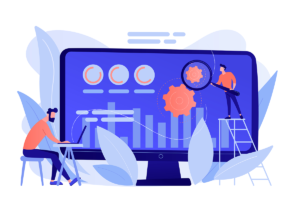Use of Visual Imagery on Websites – Best Practices that Improve Conversions

Let me start off with a well worn phrase about images, “A Picture Speaks a Thousand Words”. I know, I know it’s oft repeated and done to death, but nothing makes my point better than this cliché. Early web designers took this phrase to heart and left no stone unturned to offer visitors visual masterpieces, where the core objective was to use images as a means of creating an impact.
Make no mistake; contemporary website designers use images for the same purpose, but back then, it was only visuals…… nothing else…. there was very little or no importance given to text, features, functionalities and the overall user experience, of the website. The website was only about visual imagery and very little else. Let’s just say that it was the Ice Age of website designing, an age where even website visitors expected to be greeted by striking visuals and nothing else.
But the expectations of the website visitors, the business of website designing, the concept of visuals and everything and anything else related to the creation of websites, has evolved at a rapid clip. Yes, the use of images is still the high point of any website, but there are other elements that have also gained prominence, for example take the case of user experience. The rule of thumb is that the use of visuals in websites should be such that they enhance the user experience and do not interfere with it in any way or form.
Attention and Response
What is it that you expect your visuals to do? Yes, I know you want your graphics/images to improve your conversion ratio, but what is that behavioral action that you want to trigger in your website visitors? Well, there are not one but two things that you need to achieve, with the use of visuals and that is grab the visitor’s attention and ensure that his/her brain responds to the visuals in the way you want it to.
The idea is to create the kind of impact that will ensure the visitor takes a call-to-action. They must respond and react to your visuals in a positive manner. Now, you might think this is pretty easy, right? Just use a visual that looks good, which in turn will make visitors feel good just by looking at them and you have a winning website design on your hands?
Well, it’s not so easy. You will have to do something more than just using beautiful looking imagery if you want to make an impact. In fact, to put it more specifically, you will have to adopt the best practices with respect to the use of visuals on your site, if you want them to play a role in improving the conversion rate.
Why Best Practices?
I know, I can’t get away by saying that you need to use best practices just because they are necessary. Whenever a website designer hears the phrase ‘best practices’ alarm bells start to go off in their heads! After all, it’s not easy to follow best practices is it? It’s time consuming, it’s difficult, it’s energy sapping, and a whole lot of other things that make designers want to take a shortcut and not make the required effort to follow the ‘right way of doing things’.
But you know what; it is well worth the effort. It’s still a road less traveled, and not many website designers prefer going down this path, but in the interest of conversions, you need to take it.
You will be surprised to note that visuals work but only if they meet certain parameters. Just because you have used a particular image on your site, doesn’t mean the website visitor will fall in love with the website. They must be used in a particular way to be effective. Another thing that must be understood is that the best practices for the visual usage are all about using psychology and there is very little if anything at all of a technical nature in them.
It’s psychological principles that dictate the best practices of using visuals, so without further ado, let’s take a look at what such best practices are:
Selection of Images
Yep, this is of paramount importance. It all begins from here. I am sure you are in love with all those stock photographs that are easily available on plenty of websites, but your website’s visitors are not going to appreciate them. They are coming across the same stock photos on every other website; let’s face it, although there are plenty of options on offer, there are very few that you can actually pick from.
Say you want to pick an image of a girl with headphones on (customer service), I am reasonably sure that you and plenty of other designers who want to show such an image, will zero in on the same image. I am not joking; I have come across the same image used across plenty of websites. I am sure you wouldn’t like coming across such images, so why would your visitors.
So, be imaginative, put in some effort, and use unique images. Another thing, only use high quality images; don’t use images that are blurry, of low resolution, unclear or just look plain bad.
Something else that you should note is that you are not trying to scare people with your image. So, use images that won’t give offence, this is especially important when you are using faces or life size images. You should pick only those that are inoffensive and which you think will be appreciated by your visitors.
Image Relevance
There is yet another facet that is of paramount importance when it comes to the selection of images and that is relevance. Your images must serve to enhance the message delivered by your website, and not be a distraction for your visitors. So, choose only those images that find resonance with the theme of your website.
While choosing an image you need to analyze why and how that particular image will be beneficial for your website. What is it that a particular image can bring to the table that some other image cannot offer? This is the essential question to ask.
Think about how a particular image can convert a casual visitor into your customer or if you don’t want to look that far ahead, think about which image is perfectly suited to infuse reliability into your website. A sense of trustworthiness is something that is at the root of all successful websites that have a high rate of conversion. And what is it that brings to the website that special sense of sincerity? Yes, you got that right, it’s images. So, judge the images for their credibility quotient before you use them.
Relevance is crucial, but not without it being propped up by credibility.
So, the question is, how do you measure the relevance of your images?
This can be done by analyzing a particular image for its ability to perk up the levels of curiosity with respect to your project. It should be in perfect sync with the objective of your website, and must fit into its core idea and have a solid connection with the site. Think of your website and its content like a story that you want to tell your website visitors. Now, think whether a particular image enhances your story or not. If the answer is no, you have made the wrong decision, and if it’s yes, then you have made the perfect decision.
Another aspect to relevance is that it should ‘qualify’ what you have said on your website. If you are saying, that a certain product on your site, offers a particular benefit, then an image that is able to demonstrate that particular benefit is best suited here.
The demonstrability of your website’s USP should come across forcefully in the visuals on your website, especially the images that you use. This is what revs up the conversion ratio.
Positioning is Crucial
If there is an image on your site, this is what somebody will look at first. It’s not the text that will first grab the attention of the website visitors, but the images used on the site. It is only once the images are seen that the text is read. Also, the text, meaning the body copy is only read, if the headline is catchy enough.
This is why you come across websites that start off with an image, proceed with a catchphrase and then go on to the content. What these websites are doing is that they are drawing you, the visitor into the website, through the use of relevant images. Research estimates that if you place the headline below an attention grabbing image, the chances of it being read are more than if you don’t have an image preceding the headline, or for that matter the headline is placed above the image.
What this means is that the text should follow images and this is one of the better image placement practices you can follow. Remember, the positioning of your images or any visuals on the site, must be such that they are able to stand up and call out to the website visitors. Even a casual visitor to your site must be tempted to go through your site, because of the images used and this is only possible if their eyes fall on the image, before the text when they come to the site.
Maintaining Consistency
This is again something that is crucial to your efforts for using visuals as a means of improving the conversion ratio. The use of images should follow the visual theme chosen for your website. The overall usage of visuals should have a specific and unified emotive quality. If you want to get certain emotions out of the visitors, then you must make consistent efforts to get those emotions out. You can’t use an image that brings out emotions like passion and follow it up with an image that promotes sadness. This is an inconsistent approach that must be avoided at all costs.
Sizing of the images is also another parameter that determines the consistency of the images. An oversized visual is a strict no until and unless it’s absolutely essential; what you will need to do is identify the correct size of your images and use this size across all your images on the website. You can’t have big images on your home page and use smaller images on the internal web pages.
Something else that you also need to consider is providing your visitors with an anchor that acts as a guide for their eyes. Here, maintaining a left margin consistency will help you like nothing else can. Your images must be left aligned, so that visitors are able to follow the content which includes the text and images in an optimum manner. This ensures that they do not lose their flow and train of thought while browsing your site.
Everything with due Care
There is something that you must note about visuals that will have a bearing on your efforts to use visuals as a means to trigger your conversion ratio. Visuals have an impact on your website’s page load time and if that goes over the top, say goodbye to any chances of achieving a higher conversion rate.
So, you need to pick and choose your images with due care and use only those that are absolutely essential for helping your website make its point, and those that won’t affect the page load time of your website. So, try staying away from those glitzy images that look fantastic but push your website’s loading speed downwards. Going overboard with your visuals never helps matters.
Endowing your content with graphics is a necessity, but you will need to do it right. By following the best practices you are not assured of a great conversion ratio (it’s something that is completely unpredictable), but you markedly improve your chances of accomplishing the same.
Image Credit – Don Hankins
 Top 11 Conversion Rate Optimization Tools
Top 11 Conversion Rate Optimization Tools 5 Conversion Rate Optimization Tips All Bloggers Should Know
5 Conversion Rate Optimization Tips All Bloggers Should Know Setting Your Landing Page KPIs (The Complete Checklist)
Setting Your Landing Page KPIs (The Complete Checklist) IM Graphics Plugin For Internet Marketers
IM Graphics Plugin For Internet Marketers
{ 5 Responses }